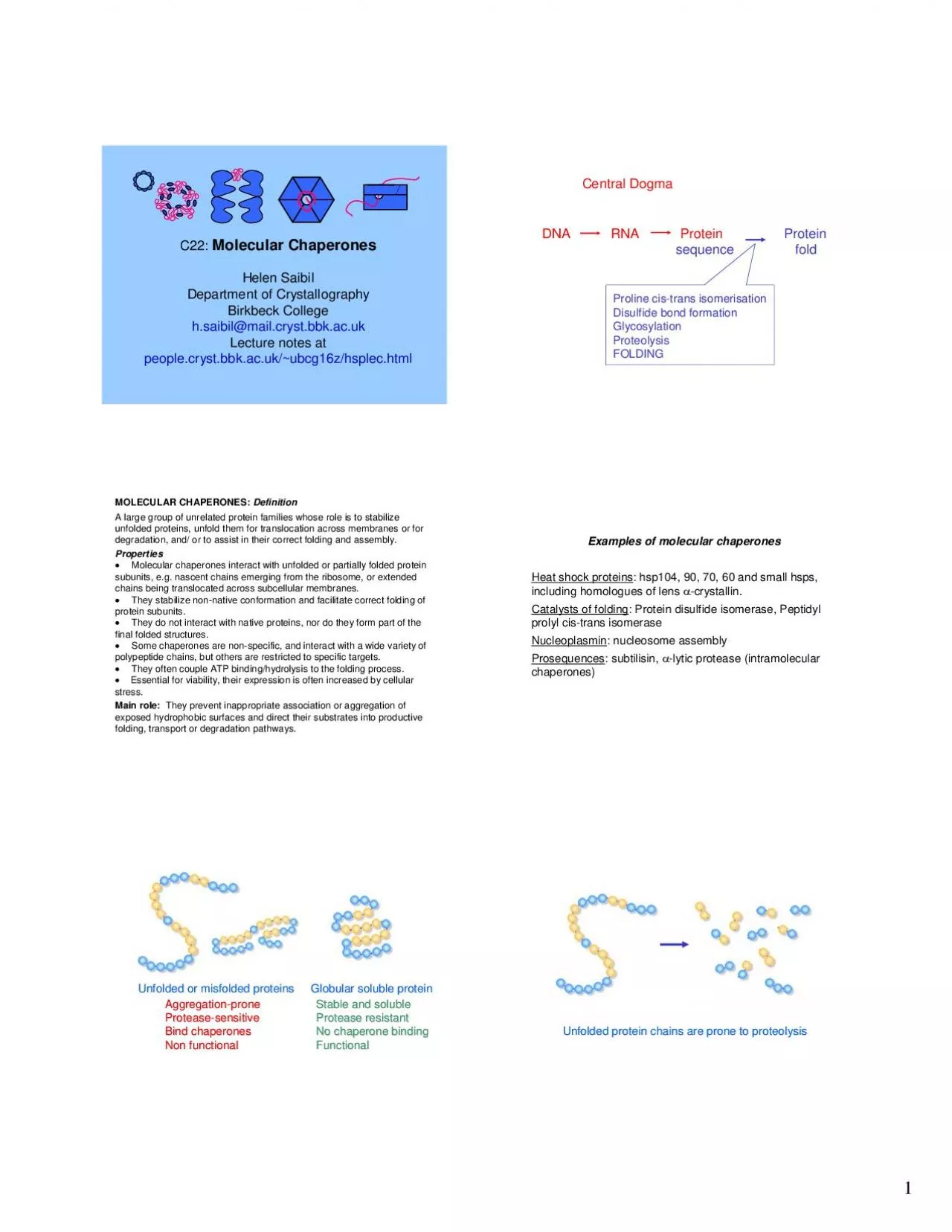

1 hsp104 90 70 60 and small hsps including homologues of lens crystallinCatalysts of folding Protein disulfide isomerase Peptidyl prolyl cistrans isomeraseNucleoplasmin nucleosomeassembl ID: 939848
Download Pdf The PPT/PDF document "Examples of molecular chaperonesHeat sho..." is the property of its rightful owner. Permission is granted to download and print the materials on this web site for personal, non-commercial use only, and to display it on your personal computer provided you do not modify the materials and that you retain all copyright notices contained in the materials. By downloading content from our website, you accept the terms of this agreement.
1 Examples of molecular chaperonesHeat shock proteins : hsp104, 90, 70, 60 and small hsps, including homologues of lens -crystallin.Catalysts of folding : Protein disulfide isomerase, Peptidyl prolyl cis-trans isomeraseNucleoplasmin : nucleosomeassemblyProsequences : subtilisin, -lyticprotease (intramolecularchaperones) Globular soluble proteinGlobular soluble proteinStable and solubleStable and solubleProtease resistantProtease resistantNo chaperone bindingNo chaperone bindingFunctionalFunctional Unfolded or Unfolded or misfoldedmisfoldedproteinsproteinsAggregationAggregationproneproneProteaseProteasesensitivesensitiveBind chaperonesBind chaperonesNon functionalNon functional Unfolded protein chains are prone to proteolysisUnfolded protein chains are prone to proteolysis 2 Folding intermediateFolding intermediateFoldedFoldedReversible aggregateReversible aggregateIrreversible aggregate Irreversible aggregate amyloidamyloid FAMILIES OF M
OLECULAR CHAPERONESSmall heat shock proteins (hsp25) [holders] protect against cellular stress prevent aggregation in the lens (cataract) Hsp60 system (cpn60,GroEL)ATPase[(un)folders] protein folding Hsp70 system (DnaK,BiP)ATPase[(un)folders] stabilization of extended chains membrane translocation regulation of the heat shock response [holder] binding and stabilization/regulation of steroid receptors, protein kinases Buffer for genetic variation?Hsp100 (Clp)ATPase[unfolder]thermotolerance, proteolysis,resolubilizationof aggregatesCalnexin,calreticulinglycoproteinmaturation in the ER quality control Folding catalysts: PDI, PPI [folders]Prosequences: alpha-lyticprotease,subtilisin(intramolecularchaperones) [folders] Molecular chaperonesMolecular chaperonesSmall heat shock Small heat shock proteinsproteinsSponges for denatured proteinsp70 sp70 Folding/unfoldingTranslocation/disaggregationChaperonins Chaperonins sp60/Hsp10sp60/Hs
p10GroESGroESNascent chain sp100sp100Clp ATPasesClp ATPasesdisaggregation sp90sp90Stabilize steroid receptors/kinases;Buffer genetic variation? ER chaperonesER chaperonesDisulfide, prolyl isomerases; oligosaccharide processing Crystal structure of sHsp fromMethanococcusjannaschi(Kim et al, 1998)A dimer of -sandwich folds forms the conserved building block of small hsps Small HspfunctionSuperfamilyincludes the eye lens protein -crystallinProtective role in suppressing protein aggregation in vivoand in vitroBind and stabilise denatured protein under conditions of cellular stress, ageing and degenerative diseaseDo not appear to have unfolding and refolding activityHigh capacity for protein binding: up to 2 denatured proteins per subunit Formation of substrate complexes Heat to 44°C with substrate protein 3 Immunoglobulin fold chaperones HSP70 FAMILYLocationChaperoneRolesProkaryoticcytosolDnaK cofactorsDnaJ,GrpEStabilizes newlysynthesis
edpolypeptides and preserves folding competence; reactivates heat-denatured proteins; controls heat-shock responseEukaryotic cytosol SSA1, SSB1(yeast)Hsc/hsp70, hsp40 (mammalian)Protein transport across organelle membranes; binds nascent polypeptides; dissociatesclathrinfrom coated vesicles; promoteslysosomaldegradation ofcytosolicproteinsKAR2,BiP/Grp78Protein translocation into ERMitochondria/ ChloroplastsSSC1 ctHsp70Protein translocation into mitochondria; Insertion of light-harvesting complex intothylakoidmembrane Substrate-binding domainATPasedomainBound peptideATP Both domains,Jianget al, 2005 Asymmetric complex of Hsp90 dimer, cofactor and substrate proteinHsp90 dimerAli et al, 2006Hsp90-cdc37cdk4 (kinase)Vaughan et al, 2006 A large and diverse family of ATPases associated with unfolding, unwinding, assembly and disassembly of protein and nucleic acid complexes (TPases ssociated with various cellular ctivities)Includes the Hsp100
/Clp family of chaperones/ proteases, components in DNA replication, recombination and restriction, the NSF protein in vesicle fusion, dynein motor proteins and many othersHsp100 proteins can totally unfold their substrate proteins, in order to deliver them to associated proteases, or they can dissolve large aggregates, in cooperation with the Hsp70 system AAA ATPases AAA module NSF 4 Hsp100 chaperoneHsp100 chaperoneprotease complexesprotease complexesSousa et al, Cell (2000)Sousa et al, Cell (2000) ATPaseProteaseATPase 10 Å Ubiquitin (8 kDa)Barnase (12 kDa) DHFR (18 kDa) Architecture of the ProteasomeArchitecture of the ProteasomeProteolytic20S Core Particle GroEL/Hsp60 -14 x 60kDsubunitsGroES/Hsp10 -7 x 10kDsubunitsfound ineubacteria, mitochondria, chloroplastsvery abundant and non-specific, will interact with most non-native proteins16 or 18 x 55kDsubunitsTF55 &thermosomeinarchaeaTCP-1 ineukaryotic cytoso�l, 8 related g
ene products TCP-1 not very abundant, foldsactin,tubulin, transducin, WD-40 domain proteins ATPhydrophobic binding sites ChaperoninsChaperoninsfolding without folding without informationinformationprotein Subunit structures:Oligomericstructures: GroELapical domainequatorial domainintermediate domainhinge 1hinge 2contact 1contact 2 binding sites Allostericstates in GroEL 7 ATP7 ATP ATPATPATP ATP binding substrate protein binding RRRTTT 5 ATPATPATPATPADPADPADPADP ATPase ADP 180° ATPATP ATPATP abcThe chaperonin functional cycle GroELATPasecycle unligandedATP-bound Conformational changes induced by ATP binding to GroEL GroEL-GroES-ADPCrystal structureGroES Rotation and separation of hydrophobic binding sites on GroEL could unfold a substrate protein bound to several sites (Shtilerman et al, 1999). GroES-bound ringApical domain movements in GroEL GroELsubunit in GroES-bound conformationThermosomesubunit in closed conformation Group IGroup I